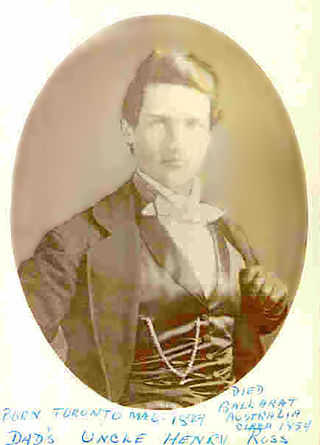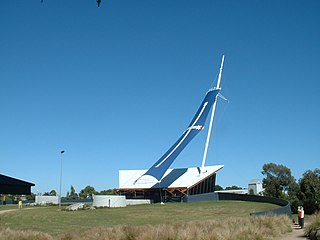Related Research Articles

The Eureka Rebellion was a series of events involving gold miners who revolted against the British administration of the colony of Victoria, Australia during the Victorian gold rush. It culminated in the Battle of the Eureka Stockade, which took place on 3 December 1854 at Ballarat between the rebels and the colonial forces of Australia. The fighting resulted in an official total of 27 deaths and many injuries, the majority of casualties being rebels. There was a preceding period beginning in 1851 of peaceful demonstrations and civil disobedience on the Victorian goldfields. The miners had various grievances, chiefly the cost of mining permits and the officious way the system was enforced.

The Victorian gold rush was a period in the history of Victoria, Australia, approximately between 1851 and the late 1860s. It led to a period of extreme prosperity for the Australian colony and an influx of population growth and financial capital for Melbourne, which was dubbed "Marvellous Melbourne" as a result of the procurement of wealth.

The Eureka Flag was flown at the Battle of the Eureka Stockade, which took place on 3 December 1854 at Ballarat in Victoria, Australia. It was the culmination of the 1851 to 1854 Eureka Rebellion on the Victorian goldfields. Gold miners protested the cost of mining permits, the officious way the colonial authorities enforced the system, and other grievances. An estimated crowd of over 10,000 demonstrators swore allegiance to the flag as a symbol of defiance at Bakery Hill on 29 November 1854. It was then flown over the Eureka Stockade during the battle that resulted in at least 27 deaths. Around 120 miners were arrested, and many others were badly wounded, including five soldiers.

Peter Fintan Lalor was an Irish-Australian rebel and, later, politician who rose to fame for his leading role in the Eureka Rebellion, an event identified with the "birth of democracy" in Australia.

John Basson Humffray was a leading advocate in the movement of miner reform process in the British colony of Victoria, and later a member of parliament.

Henry Ross was a Canadian-Australian gold miner who died in the Eureka Rebellion at the Ballarat gold fields in the British Colony of Victoria, now the state of Victoria in Australia. Ross is particularly remembered for his part in the creation of the rebel miners' flag, since named the Eureka Flag.

Henry Erle Seekamp was a journalist, owner and editor of the Ballarat Times during the 1854 Eureka Rebellion in Victoria, Australia. The newspaper was fiercely pro-miner, and he was responsible for a series of articles and several editorials that supported the Ballarat Reform League while condemning the government and police harassment of the diggers. After the Rebellion was put down, he was charged, found guilty of seditious libel, and imprisoned, becoming the only participant to receive gaol time.

James William Esmond was an Irish-Australian gold prospector and miner, and was one of the first people to discover gold in Australia.

The Age of Revolution is a period from the late-18th to the mid-19th centuries during which a number of significant revolutionary movements occurred in most of Europe and the Americas. The period is noted for the change from absolutist monarchies to representative governments with a written constitution, and the creation of nation states.

Eureka Stockade is a 1949 British film of the story surrounding Irish-Australian rebel and politician Peter Lalor and the gold miners' rebellion of 1854 at the Eureka Stockade in Ballarat, Victoria, in the Australian Western genre.

The Anti-Gold Licence Association, was formed in Bendigo, Victoria, Australia on 6 June 1853. The Association's protest became known as the Red Ribbon Rebellion, since at meetings in June and July thousands of miners gathered, wearing red ribbons around their hats, to show their solidarity in opposing the conditions imposed upon them by the government.
The following lists events that happened during 1854 in Australia.

The Ballarat Reform League came into being in October 1853 and was officially constituted on 11 November 1854 at a mass meeting of miners in Ballarat, Victoria to protest against the Victorian government's mining policy and administration of the goldfields.

Eureka is a small eastern suburb of Ballarat, Victoria, Australia. It was originally part of Ballarat East but became its own suburb in 1946 in recognition of the area's significance to Australian history. Eureka is bordered by Specimen Creek to the north, Canadian Creek to the south, Queen and Joseph streets to the west and Kline and Stawell Street to the east. The suburb takes its name from the Eureka Lead – a lead is an ancient river bed that contains gold – of the Eureka Mining Company and is most notable as the site of the historic event of the Eureka Rebellion. This was the site where the rebel miners flew the Eureka Flag for the first time; a flag that has since become a symbol of the working class and trade union movement and, at times, Australian republicanism.

Eureka Stockade is a 1907 Australian silent film about the Eureka Rebellion. It was the second feature film made in Australia, following The Story of the Kelly Gang.

The Battle of the Eureka Stockade was fought in Ballarat, Victoria, Australia on 3 December 1854, between gold miners and the colonial forces of Australia. It was the culmination of the 1851–1854 Eureka Rebellion during the Victorian gold rush. The fighting resulted in at least 27 deaths and many injuries, the majority of casualties being rebels. The miners had various grievances, chiefly the cost of mining permits and the officious way the system was enforced.
The following bibliography includes notable sources concerning the Eureka Rebellion. This article is currently being expanded and revised.

The Eureka Rebellion, an 1854 gold miner's revolt in Victoria, Australia, has been the inspiration for numerous novels, poems, films, songs, plays and artworks. Much of Eureka folklore relies heavily on Raffaello Carboni's 1855 book, The Eureka Stockade, which is the first and only comprehensive eyewitness account of the uprising. The poet Henry Lawson wrote about Eureka, as have many novelists.

The following is a comprehensive timeline of the Eureka Rebellion.

White nationalists in Australia recall the Eureka Rebellion and the eventual implementation of Victoria's Chinese poll tax in 1855 as a milestone in the formation of the 1901 Immigration Restriction Act that enshrined the White Australia Policy of the 20th century. The Eureka Flag is often featured on bumper stickers with white nationalist political slogans, and the Australia First Party has incorporated it into their official logo. Many, including Peter FitzSimons, have criticised such use by "those who ludicrously brandish it as a symbol of white Australia". However, the Lambing Flat banner that features the Southern Cross superimposed over a Saint Andrew's cross with the inscription "ROLL UP. ROLL UP. NO CHINESE". It has been claimed that the banner, which served as an advertisement for a public meeting held prior to the Lambing Flat riots, was inspired by the Eureka Flag. Nationalists have also maintained an oral tradition where the Eureka Flag was seen again on display outside NSW parliament house in 1878 at a protest brought about by the use of Chinese labour on ships at Circular Quay. Another flag similar to the Eureka Flag was seen prominently flown over a camp during the 1894 Australian shearers' strike at Barcaldine, Queensland.
References
- ↑ Bate, Weston (1978). Lucky City: The First Generation at Ballarat: 1851 - 1901. Carlton, Victoria, Australia: Melbourne University Press. p. 91. ISBN 0-522-84157-0.
- ↑ Department of Jobs, Precincts and Regions. "Recreational fossicking". Earth Resources. Retrieved 1 January 2025.
- Museum of Victoria information (brief) with images
- Australian Federal Government Eureka Stockade information
- The Eureka Rebellion published by the Australian National Republicans